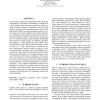Free Online Productivity Tools
i2Speak
i2Symbol
i2OCR
iTex2Img
iWeb2Print
iWeb2Shot
i2Type
iPdf2Split
iPdf2Merge
i2Bopomofo
i2Arabic
i2Style
i2Image
i2PDF
iLatex2Rtf
Sci2ools
ISMIR
2005
Springer
2005
Springer
Segmentation and Recognition of Tabla Strokes
A system that segments and labels tabla strokes from real performances is described. Performance is evaluated on a large database taken from three performers under different recording conditions, containing a total of 16,834 strokes. The current work extends previous work by Gillet and Richard (2003) on categorizing tabla strokes, by using a larger, more diverse database that includes their data as a benchmark, and by testing neural networks and treebased classification methods. First, the time-domain signal was segmented using complex-domain thresholding that looked for sudden changes in amplitude and phase discontinuities. At the optimal point on the ROC curve, false positives were less than 1% and false negatives were less than 2%. Then, classification was performed using a multivariate Gaussian model (mv gauss) as well as non-parametric techniques such as probabilistic neural networks (pnn), feed-forward neural networks (ffnn), and tree-based classifiers. Two evaluation protoco...
| Added | 27 Jun 2010 |
| Updated | 27 Jun 2010 |
| Type | Conference |
| Year | 2005 |
| Where | ISMIR |
| Authors | Parag Chordia |
Comments (0)

